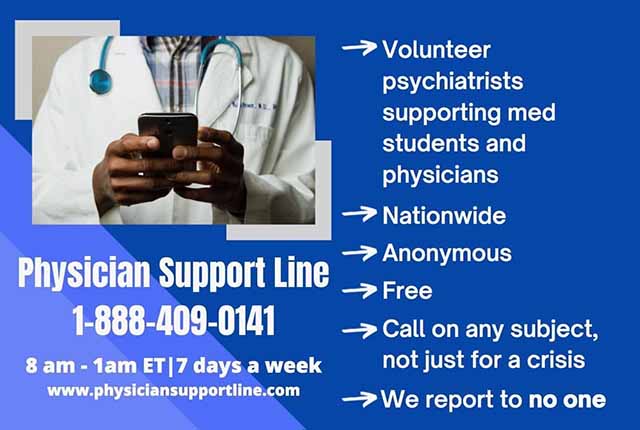“The facts are devastating. U.S. physicians have the highest rates of suicide of any profession“ – Dr. Susan Bailey, AMA past president, September 2020.
The Number of Physician Suicides in the U.S. is Alarming
It is estimated that 300-400 US physicians die by suicide each year, or approximately one per day. U.S. Physicians have the highest suicide rate of any profession, even higher than the military, and nearly double the national average, according to findings presented at the 2018 American Psychiatry Association annual meeting. The rate of suicide among male physicians is 1.4 times that of the general population. For female physicians, the rate is 2.3 times that of the general population. This grim tally is likely an undercount since many suicides aren’t listed as such on death certificates. There is still significant stigma and secrecy surrounding seeking help for mental health disorders. And it doesn’t include suicides among medical students, which are not tracked systematically in the U.S.
Physician Suicide is the Most Serious Outcome of Undiagnosed and Untreated Depression
Physician suicide is the most serious outcome of undiagnosed and untreated depression. In the past few years- the term ‘burnout’ has become very prevalent. Most physicians don’t care for this term as it places the blame on the victims, rather than looking at why this occurs. Overall, the expectation is for a doctor to be more than human. The obvious factors are that after completion of long and arduous training of medical school and residency- we are conditioned to clock long hours and ignore fatigue and the emotional toll of our work while immersed in human suffering. All this while- the lines between work and home are increasingly blurred, with more physicians reporting never being able to ‘turn off’ being a physician. In addition, although we as a profession, are inherently resilient individuals, the ever-increasing burden of bureaucratic tasks, increasing computerization of practice, increasing regulations, high expectations, loss of autonomy, and shrinking compensation only add to the burdens we face as a profession.
Prior to the COVID-19 pandemic, physicians had the highest suicide rate of any profession. Since COVID, the stress placed on physicians has increased exponentially, with constantly changing information and increasingly polarized climate surrounding the pandemic.
Stigma Surrounding Seeking Help For Mental Health Issues
One might ask why not just seek care for any mental health issues? The reason is that there is still a significant stigma surrounding seeking help. One of the major factors is the fear of disclosure on any applications for state licensure, hospital privileges, etc. Two-thirds of medical boards in the U.S. ask invasive questions regarding if you have ever had a history of mental health disorders or been treated for them. This is despite the fact that groups including AMA, APA, and FSMB recommend against it as that could be a major factor causing physicians to forego treatment.
Long-standing AMA policy encourages state licensing boards and other credentialing bodies to ensure confidentiality. A physician’s mental health should only factor into licensing and credentialling when it currently adversely affects his or her ability to practice medicine in a competent and professional manner.
Revoking licensure or otherwise preventing a physician from working due to mental disorders is actually illegal under the Americans with Disabilities Act. Yet medical boards get away with it. In some states, the question is really broad, such as, “Have you ever been treated for any mental health condition?” Instead, licensing should be based on your ability to perform your job today.
Recently, Medscape released its 2022, Medscape Physician Suicide Report. Some of the comments from physicians within the recent report include:
‘I’m afraid if I spoke to a therapist, I’d have to report receiving psychiatric treatment to credentialing or licensing boards’
‘Talking to someone makes you look like a failure, unable to cope with life’s problems’
‘Physicians cannot seek help with these issues because if we do that, these temporary issues will follow us for the rest of our career’
Also in the report, a survey of over 13,000 physicians across 29 medical specialties reveals that 21 percent noted they were depressed. Around 1 in 10 physicians said they had thought about or attempted suicide. The American Foundation For Suicide Prevention reports that 23 percent of first-year residents have suicidal thoughts. Additionally, 28 percent of medical residents in the U.S. experience a major depressive episode during residency, compared to 7-8 percent of those in a similar age range in the general population.
In response to these facts, many health systems and hospitals have created versions of physician wellness programs and have held education/training sessions to help physicians cope with their problems. Most of these consist of some combination of recommending yoga, meditation, exercise, finding time for ourselves in already full days, and investing in self-care. In other words, the burden of wellness is back on the physician rather than any real or meaningful reform to cut down endless bureaucratic tasks, streamline workflow, and give ownership to physicians to help patients, rather than create more hurdles.
Resources Available to Physicians
Among the resources available to physicians- the creation of the Physician Support Line is one of the most tangible examples of physicians supporting each other. The Physician Support Line is a national, free, and confidential support line made of 800 volunteer psychiatrists who staff this line from 8.00 am to 1.00 am seven days a week. It was started by Dr. Mona Masood in March 2020 with the mission of physicians supporting physicians as we navigate the personal and professional challenges each of us face. To reach the Physician Support Line, any U.S. medical students and physicians may call 888-409-0141. In the first year after its launch, the line had received over 2000 calls.
The first ever National Physician Suicide Awareness Day was Sept 17, 2018, and is dedicated each year to honor the memory of colleagues who have died by suicide and to continue to raise awareness and discussion on prevention.
How can each of us help a physician who may be struggling?
There is no cookbook approach. AMA has created a STEPS FORWARD toolkit to help identify and support at-risk physicians. The 4 steps include:
- Identify suicide risk factors and warning signs,
- Promote care-seeking behaviors,
- Train physician advocates
- Make it easy to get help.
The details of these steps can be found on AMA webpage.
Recent legislation
As more attention is drawn to the devastating facts of physician suicide, The Dr. Lorna Breen Health Care Provider Protection Act, was passed by Congress and signed into law by President Biden on March 18, 2022. Dr. Lorna Breen was an Emergency Medicine physician at NY Presbyterian hospital, who died by suicide on April 26, 2020, at the start of the COVID-19 pandemic. In response to this tragedy, the Lorna Breen act ‘establishes grants and requires other activities to improve mental and behavioral health among physicians and healthcare providers.
Each of us has a responsibility and a role to play
The death of a physician colleague by suicide is devastating, shocking and potentially traumatizing for all involved. It’s thru personal connection and paying attention to colleagues who may be struggling, in addition to the resources available, that we have hope that this unspoken tragedy will be prevented or reduced. Each of us has a responsibility and a role to play.
As AMA President, Dr. Gerald Harmon said in his opening address at the AMA annual meeting,
‘It’s physicians our nation turns to- for answers, for treatment, for help. You’ve taken care of our nation – at great personal sacrifice- and it’s time our nation renews its commitment to you’
Conclusion
Physician suicide in the U.S. is a serious problem. It’s the most dire outcome of undiagnosed and untreated depression. Still, physicians often don’t seek the help they need because of the unfortunate stigma surrounding mental health issues. This needs to change through increased awareness and meaningful reforms. In the meantime, significant resources are available to physicians that are struggling. Importantly, we can all play a role in helping our fellow physicians. The staggering number of physician suicides in the U.S. requires us all to recognize that our proud and noble profession is also fragile and vulnerable.
Interested in Legacy Physicians?
Legacy Physicians provides physician staffing to help hospitals deliver high-quality, compassionate care.






